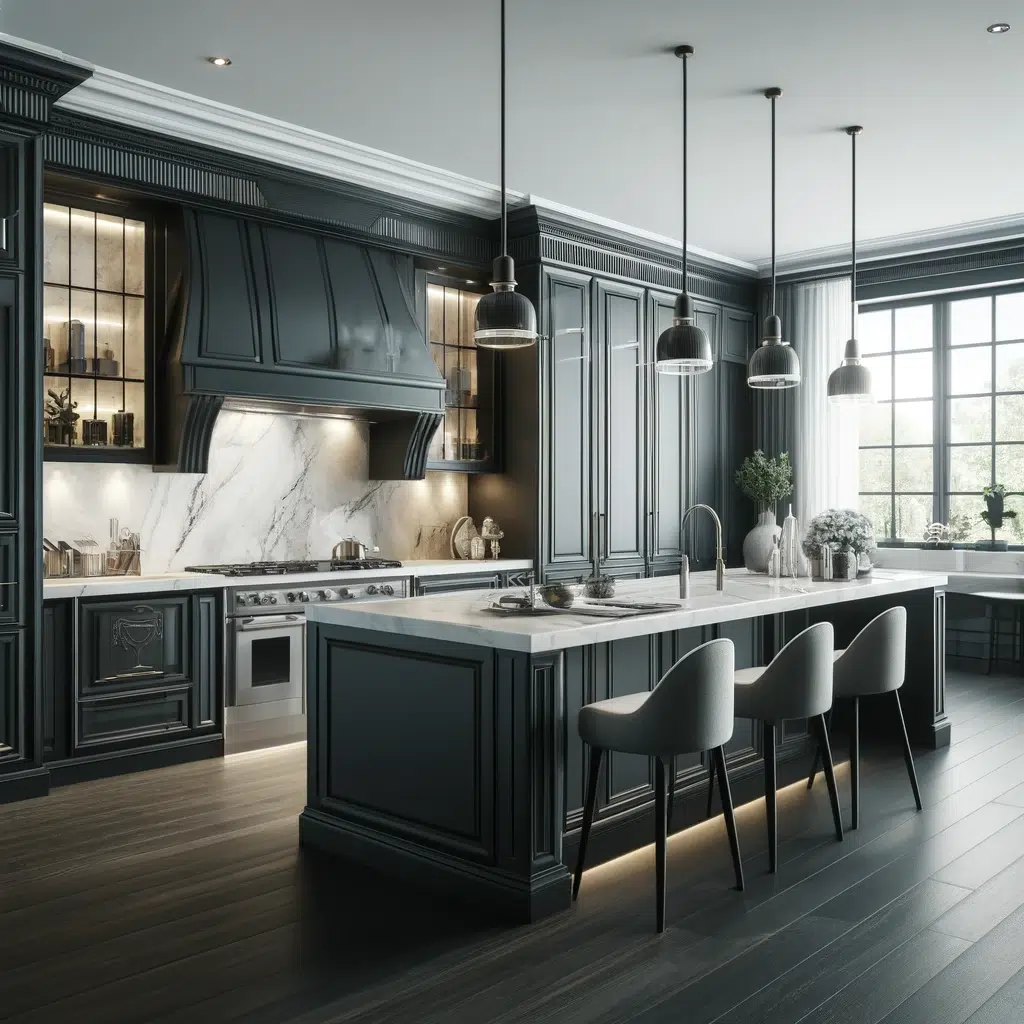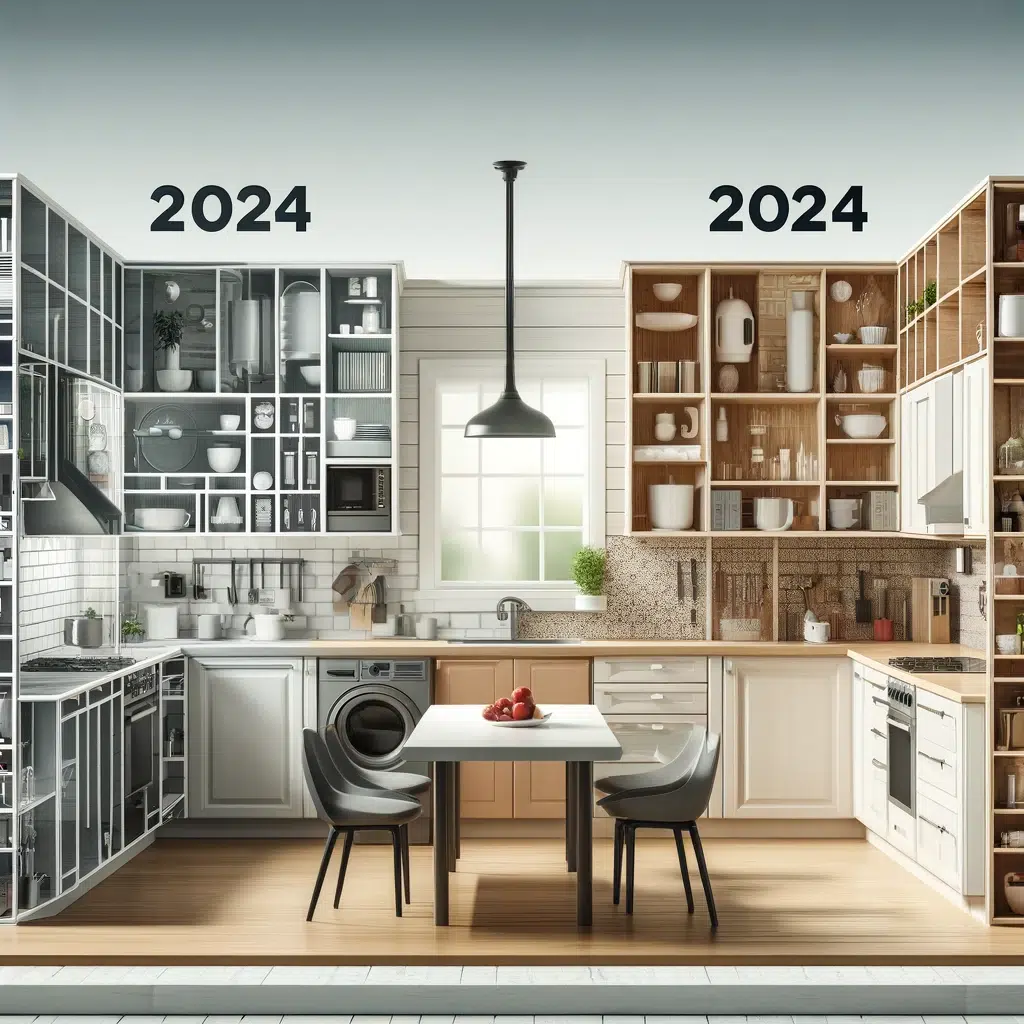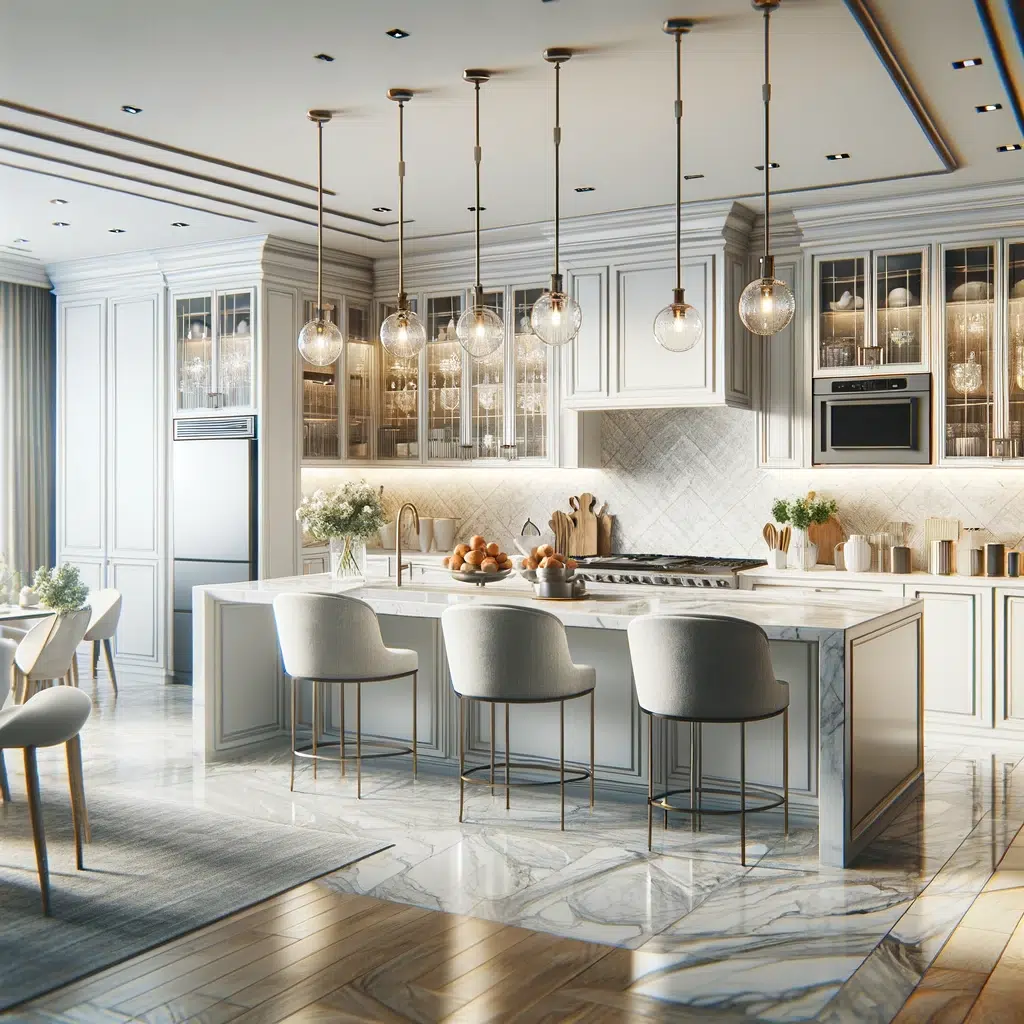Planning Your Kitchen Remodel: Key Steps to Get Started
Budgeting for Your Kitchen Remodel: What Costs to Expect
When budgeting for your kitchen remodel, it’s crucial to understand the various costs involved to prevent any financial surprises along the way.
The total expense can vary widely depending on the scope of your project, the quality of materials, and whether you’re planning structural changes or simply updating the aesthetics.
Firstly, consider the big-ticket items such as cabinetry, countertops, and appliances. These elements often consume the largest portion of the budget. Cabinetry can especially be costly, accounting for up to 30% of total expenses, depending on whether you opt for custom or stock cabinets.
Countertops also vary widely in price, with materials like laminate on the lower end and natural stone or quartz on the higher end. Appliances range from basic models to high-end versions with additional features, impacting your budget accordingly.
In addition to these costs, don’t overlook the expenses related to labor, which can include demolition, construction, plumbing, and electrical work. Labor costs can account for 20% to 35% of the total budget, influenced by the complexity of the job and local labor rates.
Also, factor in the costs for flooring, backsplash installation, and any new fixtures like sinks and faucets. It’s wise to set aside at least 10-20% of your budget for unexpected issues that may arise during the remodel.
By planning comprehensively for these expenses, you can create a realistic budget that allows for a smooth and stress-free kitchen transformation.

How to Remodel a Kitchen? Free Guide
Choosing the Right Materials for Your Kitchen Renovation
Selecting the right materials is crucial for ensuring the success of your kitchen renovation. The materials you choose will not only define the look of your kitchen but also its functionality and durability.
Here’s how to make informed choices that align with your aesthetic preferences, lifestyle needs, and budget.
1. Countertops:
The countertop is one of the most significant elements in any kitchen renovation. You have a variety of materials to choose from, each with its own benefits and drawbacks. Granite and quartz are popular for their durability and wide range of colors. Granite requires more maintenance since it needs to be sealed regularly to prevent staining. Quartz, on the other hand, offers a non-porous surface that is resistant to stains and scratches, making it easier to maintain. If you’re looking for more budget-friendly options, laminate countertops provide a cost-effective choice with a wide range of colors and designs.
2. Cabinetry:
When it comes to cabinets, you need to decide on the material and style that best fits your kitchen’s design. Solid wood cabinets are durable and can be refinished, but they are also one of the more expensive options. Thermofoil and laminate cabinets are more affordable and come in a variety of colors and finishes, but they might not last as long as wood. Consider the climate in your area as well, since wood can warp in highly humid climates.
3. Flooring:
Kitchen floors need to be durable to withstand high traffic, spills, and frequent cleaning. Hardwood floors are a classic choice that adds warmth and character to your kitchen but can be susceptible to water damage if not properly sealed. Porcelain or ceramic tiles are excellent for moisture resistance and durability, and they come in an extensive range of styles. Vinyl flooring offers a softer surface and can be a more budget-friendly option, with recent advancements making it more durable and aesthetically pleasing than older versions.
4. Backsplashes:
The backsplash not only protects your walls from spills and splatters but also adds a significant design element to your kitchen. Ceramic tiles are the most popular due to their variety of colors, shapes, and sizes. For a more luxurious look, you might consider glass tiles or high-end materials like marble.
5. Hardware and Fixtures:
The little details like drawer pulls, cabinet handles, and faucets can make a big difference in the overall look of your kitchen. Stainless steel hardware is durable and easy to clean, while oil-rubbed bronze or brushed nickel can add a touch of elegance. When choosing faucets and sinks, consider both functionality and style. High-arc faucets with pull-down spray nozzles offer convenience and flexibility, which is great for cooking and cleaning.
By carefully selecting each material based on your specific needs and the overall design you want to achieve, you can ensure your kitchen renovation will be both beautiful and functional. Always weigh the cost against the expected longevity and maintenance to get the most out of your kitchen renovation investment.

How to Remodel a Kitchen? Free Guide
The Latest Trends in Kitchen Design for 2024
As we look ahead to 2024, kitchen design trends continue to evolve, blending functionality with personalized style. These trends reflect broader lifestyle shifts toward more sustainable living, technology integration, and customized aesthetics. Here are some of the key kitchen design trends expected to dominate in 2024:
1. Sustainability at the Forefront:
Eco-friendly kitchens are becoming increasingly popular as homeowners seek to reduce their environmental footprint. Expect to see more recycled materials and sustainably sourced products, such as bamboo flooring and cabinets, recycled glass countertops, and energy-efficient appliances. These choices not only help the environment but also offer long-term savings in energy costs.
3. Bold Colors and Textures:
While white and neutral tones have been popular for years, bold colors are making a comeback. More homeowners are choosing to add personality and vibrancy to their kitchens with deep blues, greens, and even tones of black. Textured cabinets and countertops are also on the rise, adding depth and interest to the kitchen space.
4. Open Shelving and Glass Fronts:
There’s a growing trend towards open shelving and glass-fronted cabinets, which help create a sense of openness and space. These features allow homeowners to display beautiful dishware and decorative items, making the kitchen feel more personal and inviting.
5. Multipurpose Islands:
Kitchen islands are becoming more versatile and functional. Beyond just extra countertop space, islands in 2024 are expected to include features like built-in appliances, ample storage, and even designated dining areas. Some islands are also being designed to serve as home office spaces, reflecting the increasing blend of living and working environments.
6. Integrated Living Spaces:
As the heart of the home, kitchens are being designed to flow seamlessly into other living spaces. This includes larger transitional areas that accommodate dining, relaxing, and entertainment, supporting a more fluid lifestyle between cooking, eating, and socializing.
7. Minimalist Design with a Twist:
The minimalist trend continues, but with a twist. Simple, clean lines and uncluttered spaces remain popular, but with added elements of luxury, such as high-end materials and statement lighting. This blend of minimalism and luxury creates a sophisticated yet functional kitchen environment.
These trends for 2024 not only reflect changing aesthetic preferences but also a shift towards more dynamic and technologically integrated kitchen spaces. As you plan your kitchen remodel, consider these trends to ensure your kitchen is both stylish and aligned with the latest innovations.
DIY Kitchen Remodeling Tips: What You Can Do Yourself
Embarking on a DIY kitchen remodel can be a rewarding experience that not only enhances your living space but also boosts your home’s value. Here are some practical DIY kitchen remodeling tips that homeowners can tackle themselves, ensuring a successful upgrade without the need for professional help:
1. Painting Cabinets:
One of the most impactful changes you can make is painting your kitchen cabinets. This can transform the look of your kitchen dramatically. Choose a durable paint designed for cabinetry to ensure it stands up to the wear and tear of kitchen use. Make sure to clean, sand, and prime the cabinets thoroughly before applying the new color for the best results.
2. Updating Hardware:
Replacing old cabinet knobs and drawer pulls with new hardware is an easy and inexpensive DIY project that can modernize your kitchen. Hardware comes in various styles and finishes, allowing you to add a personal touch to your cabinets and drawers.
3. Installing Backsplash:
Adding or updating a backsplash can add color and personality to your kitchen. Materials like peel-and-stick tiles offer an accessible option for DIYers and can be found in a variety of styles that mimic more expensive ceramic or glass tiles.
4. Replacing Fixtures:
Changing out old kitchen faucets and sinks can make a notable difference in your kitchen’s functionality and appearance. Modern fixtures often come with DIY-friendly installation instructions that homeowners can follow without needing professional plumbing skills.
5. Updating Lighting:
Enhancing or changing the lighting in your kitchen can improve both the ambiance and the usability of your space. Consider installing new LED fixtures under cabinets for task lighting or replacing an old chandelier over the dining area with something more contemporary and bright.
6. Refinishing Countertops:
If your countertops are in good shape but need a refresh, consider refinishing them instead of a complete replacement. There are several DIY kits available that allow you to repaint or resurface countertops with materials like epoxy for a fresh, new look.
7. Organizing Storage:
Improving kitchen storage can be as simple as adding pull-out baskets, lazy Susans, or additional shelving inside existing cabinets. These enhancements can make accessing items more manageable and keep your kitchen organized.
8. Laying New Flooring:
If you’re confident in your DIY skills, installing new flooring can be a transformative project. Options like vinyl planks or laminate can be relatively easy for homeowners to install and come in a variety of styles that mimic hardwood or tile.
When tackling DIY projects, it’s important to do thorough research and preparation beforehand. Watching tutorial videos, reading manuals, and maybe even attending a workshop can equip you with the necessary skills and knowledge. Always prioritize safety by wearing appropriate gear and turning off electricity or water when working on related projects. With these tips, your DIY kitchen remodel will not only be a fun and fulfilling project but also a great investment into your home.
Hiring Professionals: When to Call in the Experts
While DIY kitchen remodeling can be a rewarding and cost-effective approach, there are certain aspects of a kitchen renovation that typically require the expertise of professionals. Knowing when to call in the experts can save you time, ensure quality work, and prevent costly mistakes. Here are key scenarios where it’s advisable to hire professional contractors:
1. Structural Changes:
If your remodel involves altering the structure of your home, such as removing walls or changing the layout significantly, it’s essential to hire a professional. Structural changes can affect the integrity of your home and often require permits and inspections that professionals are equipped to handle.
2. Electrical and Plumbing Work:
Any updates that involve electrical or plumbing changes should be handled by licensed professionals. Incorrect installations can pose serious safety hazards and may violate local building codes, potentially leading to issues when it’s time to sell your home.
3. Installing Countertops:
While some materials might be manageable on a DIY basis, stone countertops like granite, marble, or engineered quartz typically require professional installation. These materials are heavy and require specialized tools and knowledge to cut and install properly.
4. Major Appliance Installation:
Installing new appliances that require electrical or gas connections, such as stoves and ovens, should generally be done by professionals to ensure safety and efficiency. They can also help you ensure that your new appliances are properly integrated into your existing kitchen layout.5
5. Custom Cabinetry:
If you opt for custom cabinetry, professional cabinet makers and installers can ensure that the units are perfectly tailored to your space and needs. They have the tools and expertise to handle complex installations that might involve uneven walls or specific design requirements.
6. Flooring Installation:
While some flooring types like vinyl or laminate can be DIY-friendly, materials like hardwood or tile often yield better results when installed by professionals. They can ensure that the subfloor is properly prepared and that the installation is executed to last.
7. Finishing Work:
Tasks like tiling backsplashes or achieving a perfect paint finish can sometimes be more challenging than they appear. Professionals ensure these finishing touches are executed with precision, which can significantly impact the overall look of your kitchen.
8. Permitting and Inspections:
Professionals can navigate the permitting process and ensure that all aspects of your remodel meet local building codes and regulations. This is crucial for avoiding legal issues and ensuring that your remodel enhances your home’s value without future complications.
Hiring professionals for these key tasks ensures that your kitchen remodel is not only beautiful but also safe, functional, and compliant with all local standards. It’s worth investing in expert help for these critical elements to ensure your kitchen is a lasting investment in your home’s comfort and value.
Design Ideas for Small Kitchens
Designing a small kitchen presents unique challenges, but with the right strategies, you can maximize both functionality and style. Here are several design ideas tailored for small kitchens that help create a more spacious and efficient cooking environment:
1. Opt for Light Colors:
Light colors make spaces feel larger and more open. Use whites, light grays, or pastels for your cabinetry, walls, and backsplash tiles. Glossy finishes can also help reflect light, enhancing the sense of space.
2. Embrace Minimalism:
Keep your countertop clutter-free by using streamlined appliances and clever storage solutions. Opt for sleek, compact models of appliances specifically designed for small spaces. Minimalist designs with clean lines create a more organized and less crowded feel.
3. Utilize Vertical Space:
Maximize vertical space by installing cabinets up to the ceiling. This not only increases storage capacity but also draws the eye upward, creating the illusion of height. Open shelving can be used to keep essentials within easy reach and reduce the heaviness of solid cabinets.
4. Choose Reflective Surfaces:
Incorporate materials that reflect light, such as stainless steel for appliances, glossy tiles for backsplashes, or glass for cabinet doors. These surfaces help bounce light around the room, making it feel larger and more open.
5. Implement Smart Storage Solutions:
Utilize every inch of space with smart storage options. Install lazy Susans in corner cabinets, drawer dividers for utensils, pull-out pantries, and integrated spice racks. Consider multi-functional furniture, like a kitchen island that can serve as both a prep area and dining space.
6. Incorporate Effective Lighting:
Good lighting is crucial in small kitchen designs. Combine under-cabinet lighting with overhead lights to brighten work areas effectively. Consider adding a focal light fixture above the sink or island to add style and functionality.
7. Choose Slimmer Cabinets:
Opt for slimmer cabinets or even custom sizes that can fit more snugly into your available space. Reducing cabinet depth can free up more floor area, making the kitchen feel less cramped.
8. Add Mirrors:
Strategically placing mirrors in a kitchen can visually expand the space by reflecting both artificial and natural light as well as the kitchen’s interior.
9. Integrate Appliances:
Integrated appliances that blend into the cabinetry create a seamless look and can make the kitchen appear larger. Panel-ready appliances designed to be covered with cabinet fronts are an excellent choice for small kitchens.
By employing these design ideas, you can transform a small kitchen into a functional, stylish space that feels larger and more welcoming. Each decision from color scheme to storage solutions should focus on maximizing space without sacrificing the kitchen’s aesthetic appeal or practicality.
Incorporating Energy Efficiency into Your Kitchen Remodel
Incorporating energy efficiency into your kitchen remodel not only helps reduce your environmental footprint but also cuts down on utility bills, making it a smart and sustainable choice. Here are effective ways to ensure your kitchen remodel is energy-efficient:
1. Energy-Efficient Appliances:
Choose ENERGY STAR certified appliances, which are tested and verified to meet strict energy efficiency guidelines set by the U.S. Environmental Protection Agency. ENERGY STAR refrigerators, dishwashers, and ovens use significantly less energy than standard models, which can lead to substantial savings over time.
2. LED Lighting:
Replace old incandescent light bulbs with LED lighting options. LEDs are more energy-efficient, last longer, and are available in a range of colors and luminosities to fit any kitchen design. Consider task lighting under cabinets and recessed lighting in ceilings to brighten your workspace efficiently.
3. Sustainable Materials:
Opt for materials that are not only durable but also sustainably sourced. Bamboo, recycled glass countertops, and reclaimed wood are eco-friendly choices that add unique style and character to your kitchen while being kind to the planet.
4. Efficient Water Use:
Install low-flow faucets and dishwashers that reduce water use without compromising performance. These fixtures can significantly decrease the amount of water used in the kitchen, helping to conserve this vital resource.
5. Proper Insulation and Windows:
Ensure that your kitchen is properly insulated and that windows are energy-efficient. Good insulation keeps heat from escaping during winter and keeps it out during summer, reducing the need for heating and cooling. Energy-efficient windows, such as double-glazed or low-E coated windows, help minimize heat loss and gain.
6. Smart Kitchen Technology:
Smart thermostats and appliances can optimize energy use by adjusting settings automatically based on your usage patterns. Smart refrigerators, ovens, and dishwashers can be programmed to run at times when energy costs are lower, and smart faucets can reduce water waste.
7. Solar Power Integration:
If possible, consider integrating solar power into your kitchen’s energy source. Solar panels can power your appliances, lighting, and other electrical systems in the kitchen, substantially reducing your reliance on non-renewable energy sources.
8. Ventilation Efficiency:
An energy-efficient ventilation system helps improve air quality while conserving energy. Look for range hoods and ventilation systems that have adjustable speeds and are sized appropriately for your stove to ensure effective operation without excessive energy use.
By incorporating these energy-efficient practices and products into your kitchen remodel, you not only make your space more environmentally friendly but also enhance its functionality and long-term cost-effectiveness. This approach not only benefits the planet but also adds value to your home by making it more attractive to eco-conscious buyers.
Navigating permits and regulations is a crucial step in any kitchen remodeling project, ensuring that all modifications are up to code and legally compliant. This process can be complex, but understanding and adhering to local building codes will help avoid legal complications and ensure safety. Here’s a guide to help you through the permitting process for your kitchen remodel:
1. Determine the Need for Permits:
Not all kitchen remodels require permits, but major renovations involving structural changes, electrical or plumbing alterations typically do. Simple cosmetic updates like painting or replacing cabinetry usually don’t need permits. It’s important to check with your local building department in Naperville to understand which aspects of your remodel may require a permit.
2. Understand Local Codes and Regulations:
Building codes vary by location and are designed to ensure the safety of the construction and its future occupants. These regulations cover a wide range of construction elements, including electrical wiring, plumbing, structural integrity, and fire safety. Familiarizing yourself with these codes is essential. Your local building authority or a professional contractor can provide guidance.
3. Hire Licensed Contractors:
For any work requiring a permit, it’s generally advisable to hire licensed professionals. Licensed contractors are familiar with the building codes and permitting process in your area. They can ensure that all work is compliant and can often handle the permit application process for you.
4. Prepare and Submit Necessary Documentation:
Applying for permits typically involves submitting detailed plans of your proposed remodel, including architectural drawings and exact specifications of the work to be done. These plans may need to be prepared by a qualified professional, depending on local requirements. The more detailed and accurate your submissions, the smoother the review process will be.
5. Schedule Inspections:
Once your permit is approved, and as your remodel progresses, your local building department will require inspections to ensure the work complies with the plans and local codes. These inspections are typically needed after certain phases of the work are completed but before anything is sealed up. Planning for and scheduling these inspections is crucial to avoid delays in your project timeline.
6. Addressing Delays and Rejections:
If your permit application is rejected or you face delays, it’s important to understand the reasons provided by the building department. Common issues can often be resolved by revising your plans to meet the required codes or by providing additional information. Persistence and open communication with the permitting officials can help resolve issues efficiently.
7. Final Approval:
Upon completion of the remodel, a final inspection is usually required to ensure all work has been done according to plan and that it meets all safety standards. Once approved, you will receive a final sign-off, which is often necessary for closing project permits officially.
Navigating permits and regulations may seem daunting, but it’s a fundamental part of the remodeling process that ensures your kitchen is safe, functional, and adds value to your home in compliance with all local legal standards.
Post-Remodel: Maintenance Tips for Your New Kitchen
After completing your kitchen remodel, maintaining your new space properly will help extend its longevity and keep it looking beautiful. Here are essential maintenance tips to ensure your remodeled kitchen continues to function efficiently and stays in pristine condition:
1. Countertop Care:
- Natural Stone (Granite, Marble): Regularly seal stone countertops to prevent staining and bacteria growth. Wipe spills immediately, especially acidic substances like lemon juice or tomato sauce, which can etch the surface.
- Quartz: Although durable and non-porous, avoid placing hot pots directly on quartz surfaces. Use mild soap and water for daily cleaning.
- Laminate: Use a damp cloth and a mild detergent for cleaning. Avoid abrasive cleaners and pads that can scratch or damage the surface.
2. Cabinet Maintenance:
- Wood Cabinets: Dust regularly and clean using a soft, damp cloth. Avoid using harsh chemicals that can strip the finish. Every few months, apply a good quality furniture polish to keep the wood nourished.
- Laminate and Thermofoil Cabinets: Wipe down with a mild detergent solution. For grease splatters, use a solution of vinegar and water.
3. Appliance Upkeep:
- Refrigerators: Clean the coils every six months to ensure efficiency. Regularly check and clean the door seals to maintain proper temperature.
- Ovens and Stovetops: Clean spills immediately to prevent buildup. Use the self-cleaning function sparingly as it can significantly reduce the lifespan of the appliance.
- Dishwashers: Clean the filter monthly and run a dishwasher cleaner through a cycle periodically to keep it running smoothly.
4. Sink and Faucet Care:
- Stainless Steel Sinks: Avoid leaving metal pans in the sink as they can cause rust marks. Clean regularly with baking soda and water to maintain shine.
- Faucets: Hard water can leave deposits. Use vinegar to clean faucets and aerators to keep water flowing freely.
5. Floor Care:
- Tile Flooring: Sweep or vacuum regularly. Clean up spills promptly to prevent slipping or staining. Use a damp mop with a mild detergent for cleaning.
- Hardwood Floors: Use mats at entrances to catch dirt. Sweep regularly and use a wood cleaner with a microfiber mop for cleaning. Avoid water pooling.
6. Ventilation:
- Keep the kitchen well-ventilated, especially if you cook frequently. This helps manage moisture and odors that can affect your kitchen cabinetry and appliances over time.
7. Regular Inspections:
- Periodically check under the sink for leaks and look for any signs of water damage or mold in cabinets and walls. Early detection can prevent major repairs later.
By following these maintenance tips, you can enjoy your newly remodeled kitchen for many years to come. Regular care not only helps in maintaining the aesthetic appeal of your kitchen but also ensures that everything continues to operate efficiently and safely.


